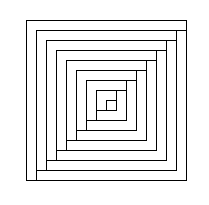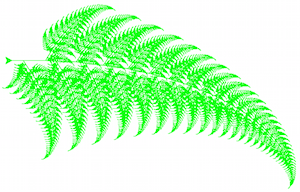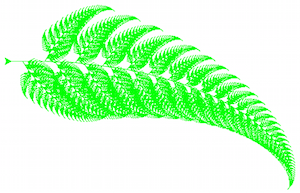CS101 - Homework 5
Due: 2018-03-21 11:59p
Objectives
- Gain more practice with recursion
- Gain practice with iteration (for loops and while loops)
- Gain practice with lists
[10 points] Prelab
Before coming to lab on Thursday / Friday, read this entire homework
write-up and complete the prelab.
[10 points] Stairs
 Using turtle graphics, write a recursive function
Using turtle graphics, write a recursive function drawStairs(len,
levels) to draw pictures such as the one to the right. Assume
the turtle starts in the top left corner, facing right. The
first square should have a side length of "len", and each subsequent
square should have 1/2 the size. There should be a total of "levels"
squares. Do this all in one continuous drawing motion; Do not pick up the pen,
and do not repeat any lines. Employ the following strategy: (1) draw a half-square,
(2) recursively draw the rest of the squares, (3) draw the last
half-square to return to the starting position and orientation.
For testing, feel free to use the following code.
def drawStairsScene():
"""
Moves the turtle to the top left of the screen and draws a staircase.
"""
# pick up the pen and move the turtle so it starts at the left edge of the canvas
turtle.penup()
turtle.goto(-turtle.window_width()/2 + 20, turtle.window_height()/2 - 20)
turtle.pendown()
# draw the tree by calling your function
drawStairs(200,5)
# finished
turtle.done()
[5 points] Testing for primality
Write a function isPrime(n) that tests whether its input
parameter n is prime or not. Input can be assumed to be a positive integer;
output is True or False. Use a for loop. (Recall that the primes include
2, 3, 5, 7, 11, 13, 17, 19, 23, ...)
[5 points] Print primes
Write a function printPrimes(n) that prints the first n
primes. For example, printPrimes(5) would print 2, 3, 5, 7, 11.
Input can be assumed to be a positive integer.
Use a while loop.
[5 points] GCD, take 2
Write a function GCD2(a,b) that uses a loop
(for or while?)
to determine the greatest common divisor of a and b.
[5 points] Encryption
In class we discussed a simple function shift_letter(c, num)
that returns the character in variable c shifted by num, eg, shift_letter('b',3)
would return 'e'. The characters used include the lowercase letters followed by a space, ie,
'abcdefghijklmnopqrstuvwxyz ', so shift_letter('y',4) would return 'b'.
Use this function to help you implement a simple Caesar encryption method.
Write a function caesar_encrypt(msg, shift) that "encrypts" the text in msg
by shifting each character by shift characters.
To decrypt a message, we can use our caesar_encrypt function, but
now, give it a negative number. Encrypt a
message or two and make sure that you can decrypt them.
Decrypt the following message with number offset 5:
htruzyjwexhnjshjenxestertwjefgtzyehtruzyjwxeymfsefxywtstrcenxefgtzyeyjqjxhtujx
You don't have to write it down,
but it's a good check to make sure you've got things working.
Keep in mind our encryption schemes will only work for lowercase letters
a-z and space.
(You
don't need to do any error checking of the input, just assume it is composed
of spaces and lowercase letters.)
[5 points] First primes
Write a function firstPrimes(n) that
returns a list containing the first n
primes. For example, firstPrimes(5) would return
the list [2, 3, 5, 7, 11].
Input can be assumed to be a positive integer.
Use a while loop.
[5 points] Factors
Write a function factors(n) that
returns a list containing all factors of
input parameter n.
For example, factors(5) would return the list [1, 5].
factors(32) would return the list [1, 2, 4, 8, 16, 32].
Input can be assumed to be a positive integer.
Use a for loop.
Optional - Challenge problem 1 [2 extra points]
 Make a copy of your code from the
Make a copy of your code from the drawStairs() problem and modify it to
draw pictures like the one on the right. Unlike in the previous
problem, here it is ok to retrace steps or draw the same line twice.
Only very slight changes to your code from the previous problem should
be required. However, your recursive function should now only have one
parameter 'len', the sidelength of the overall figure. The line
spacing within the figure should be 10 pixels. We used side length of
200 to generate this picture.
Optional - Challenge problem 2 [2 extra points]

Use Turtle graphics to draw the
recursive leaf shown here
and to the right.
To help with choosing
values for constants, this picture was generated with the following
settings:
- initial stem length is 50
- the base case stops drawing if the stem length <= 0.2
- the next leaf to the front is .9*stemLength, to the right by 3 degrees
- the leaf on the left is .28*stemLength, to the left by 60 degrees
- the leaf on the right is .33*stemLength, to the right by 55 degrees,
drawn one-third of the way up the stem
More challenge [1 extra point]:
Notice that the leaves on the above image curl both up and down.
Find an elegant
way to revise your code so that all the leaves curl up as in the
recursive leaf shown here
and below.

Optional - Challenge problem 3 [2 extra points]
Write a function sumNested(L) that takes in a nested list
of integers and returns the sum of all the lists. A nested
list of integers contains 0 or more integers AND 0 or more
nested lists of integers. For example,
sumNested([]) = 0
sumNested([1, 2, 3, 4, 5]) = 15
sumNested([1, [2, [3]], 4, 5]) = 15
sumNested([1, [2, [3], []], [], 4, 5]) = 15
sumNested([[2, 4, 6, 8], [3, 6, 9], [1, [1, 10]]]) = 50
Hint: The isinstance() function may be of use --
run help(isinstance) in your shell.
Turning in your work
Before submitting, see the grading rubric
and make sure you have followed all instructions correctly.
Please put
all of your functions into a single Python file called
username_hw5.py, where username is your Middlebury
username.
Be sure to comment your code. The top of the file should include a
multiline comment that lists your name, the name of the assignment,
and the date, at a minimum. Each function should also include a
multiline comment (enclosed in triple-quotes) at the beginning of the
body of the function describing what the function does.
Take a screenshot of your output for the stairs problem (and
for any of the challenges that you complete as well).
(On a Mac use Cmd-Shift-4 to select a region on the screen; on Windows
use the Snipping Tool application. The resulting screenshot will be
saved to the desktop.)
Please submit your file username_hw5.py as well as your
screenshot(s) using the
CS 101 submit script. You will need to use
the script once for every file that you submit. Please enter the same amount
of time each time you fill out the form.
 Using turtle graphics, write a recursive function
Using turtle graphics, write a recursive function  Make a copy of your code from the
Make a copy of your code from the 
